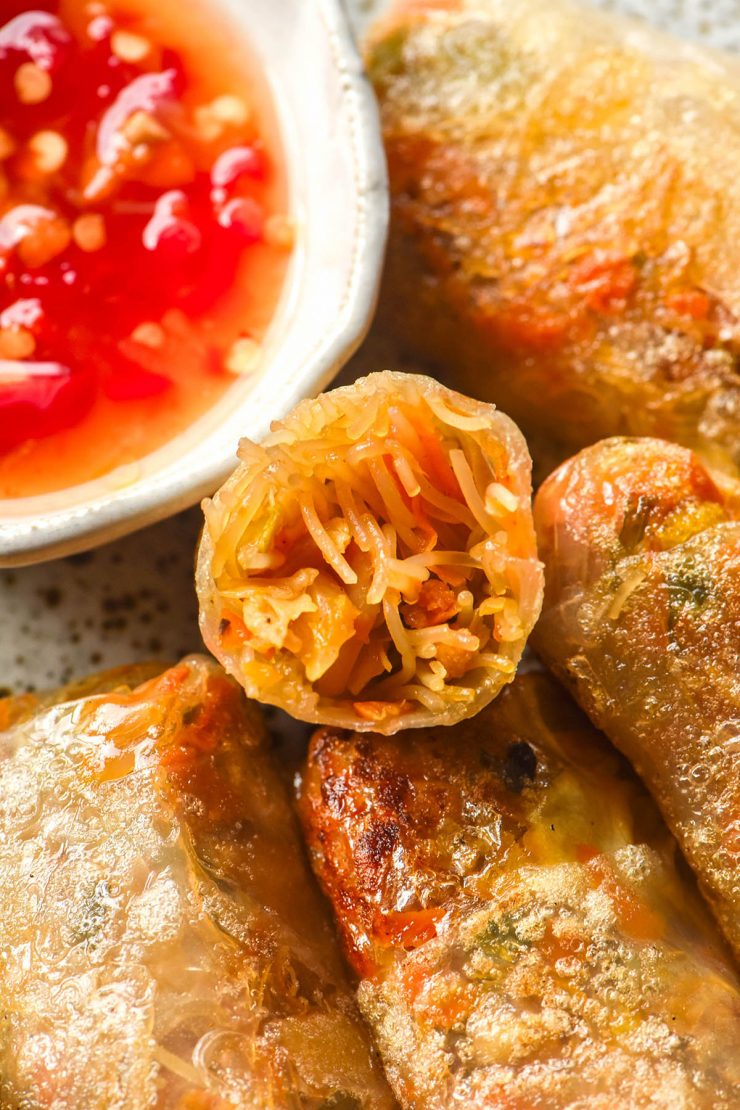
Like the Vietnamese inspired rice paper roll filling in Intolerance Friendly Kitchen, I find this recipe impossible not to eat by the spoonful (or bowlful). It is so good that I could easily make a batch and eat it for dinner, no spring rolls necessary. Whatever you do with it, I hope you enjoy this easy and delicious low FODMAP spring roll filling as much as I do.
Low FODMAP spring roll filling (vegan)
This spring roll filling has a simple list of ingredients but they really come together to make the most delicious result. The filling is gluten free, vegan, nut free and soy free.
Carrot and common cabbage are salted and squeezed to remove excess moisture.
Next, spring onion greens, shiitake and plenty of ginger are sautéed until fragrant and delicious (some low FODMAP pickled garlic would also be a delicious addition here).
The drained carrot and cabbage are returned to the pan, along with some soaked and roughly chopped rice vermicelli noodles. The mixture is then cooked through and seasoned with vegetarian oyster sauce.
And that’s it! An incredible amount of flavour with so few ingredients.
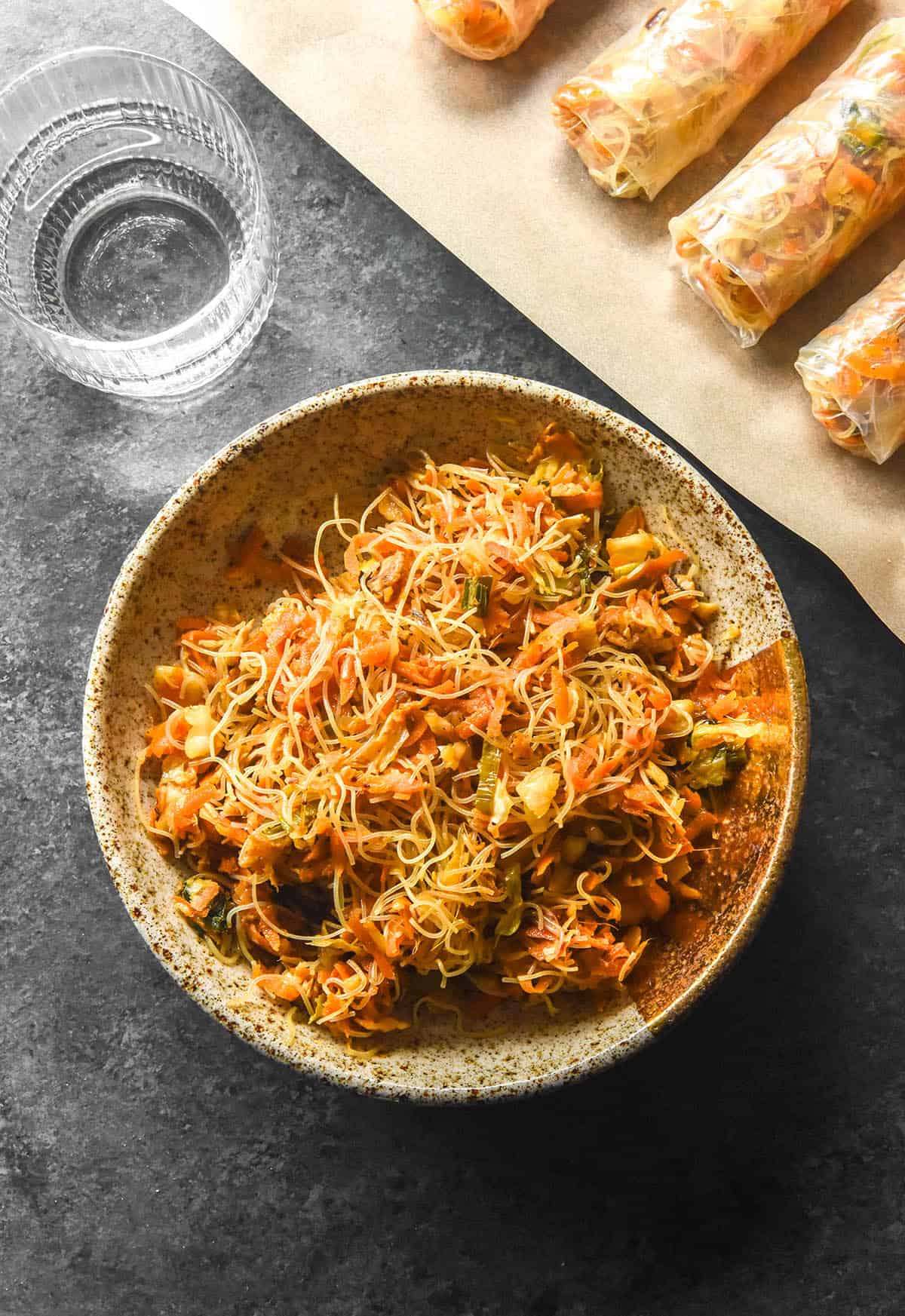
FODMAP notes
These FODMAP thresholds are from the Monash FODMAP app and are current as of June 2025. They will be periodically reviewed to ensure they remain up to date.
Common cabbage has the biggest quantity for a low FODMAP serving of all the cabbages. It is low FODMAP in 75g and contains moderate amounts of fructan in serves exceeding 194g. See the section below if you intend to serve this dish solo. This recipe uses 250g common cabbage and serves 4.
Vegetarian or vegan Oyster sauce is low FODMAP in 20g (1 Australian tablespoon) serves. However, it doesn’t become moderate for fructose until it exceeds 104g (5 tablespoon) serves. Make sure you read the labels to check for any high FODMAP ingredients.
Spring onion greens are low FODMAP in 75g serves and remain low FODMAP until they exceed 97g serves per person.
Rice vermicelli are low FODMAP in 120g serves and Monash specifies that they remain low FODMAP in serves of up to 500g. Make sure you get rice vermicelli, as wheat vermicelli also exist.
We will discuss the shiitake mushroom in depth below.
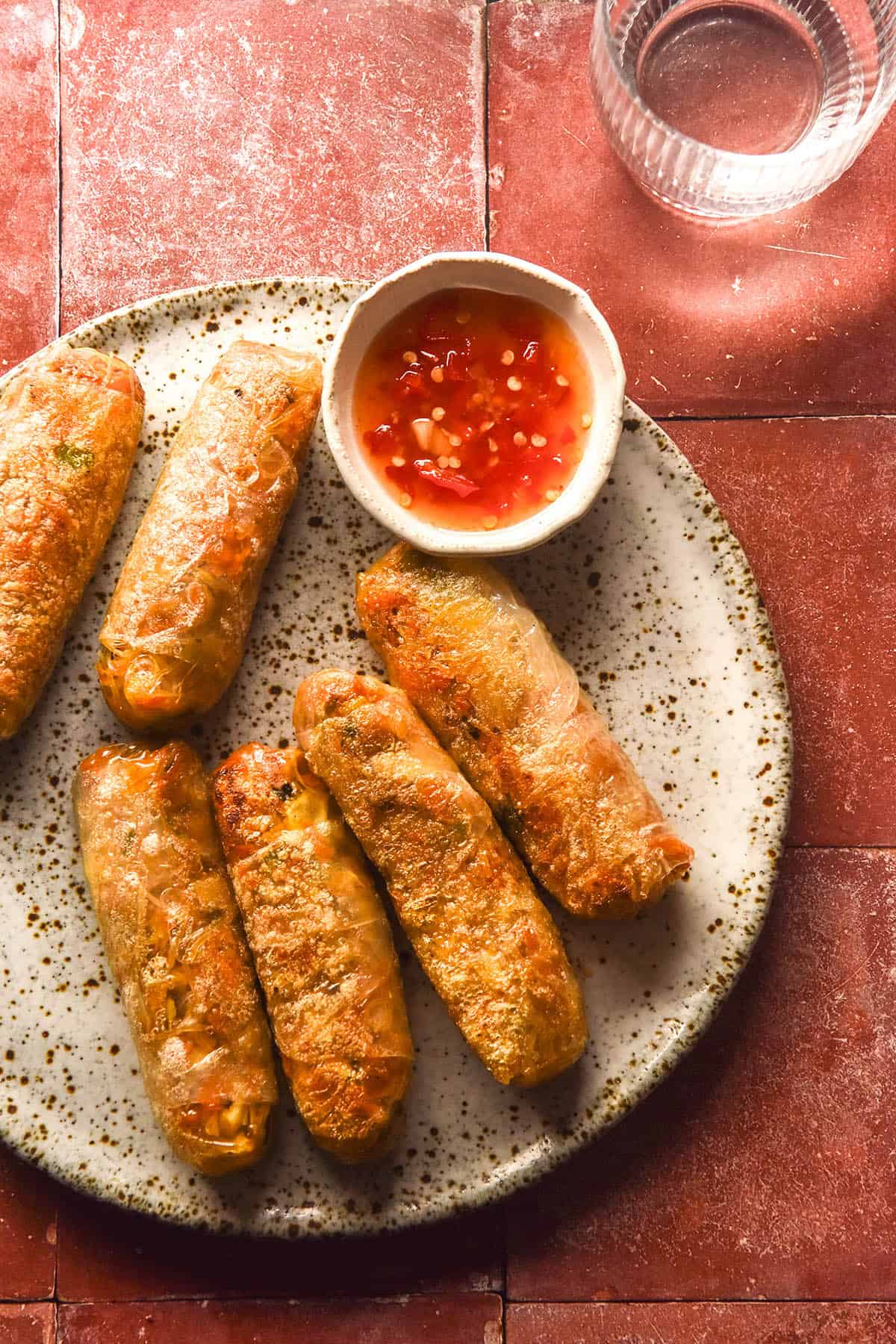
Are shiitake mushrooms low FODMAP?
Let’s chat some shiit(ake). Because shiitake pack such a flavour punch, we don’t need to use too many of them. This is handy, because shiitake don’t have a huge FODMAP threshold.
Fresh shiitake mushrooms are low FODMAP in 11g serves. In serves of 17g or more, they contain moderate amounts of mannitol. In serves of 75g or more, they contain high amounts of mannitol.
Dried shiitake are low FODMAP in 8g serves. In 13g serves they contain moderate amounts of mannitol and they are high in mannitol in serves exceeding 15g.
How many shiitake mushrooms are which variety you add (fresh or dried) is personal to you. I have provided a ranged serving size, but you know yourself better than I do.
Keep in mind what you intend to use this low FODMAP spring roll filling for. If you are indeed making spring rolls, you might be able to use more shiitake. The spring roll recipe makes around 13 medium rice paper rolls, meaning just over 3 rolls would be a low FODMAP serve. If you intend to eat it as a dish, it makes about 2 servings (but see below re: cabbage).
Keep in mind, too, what your tolerances are for mannitol. Everyone is different!
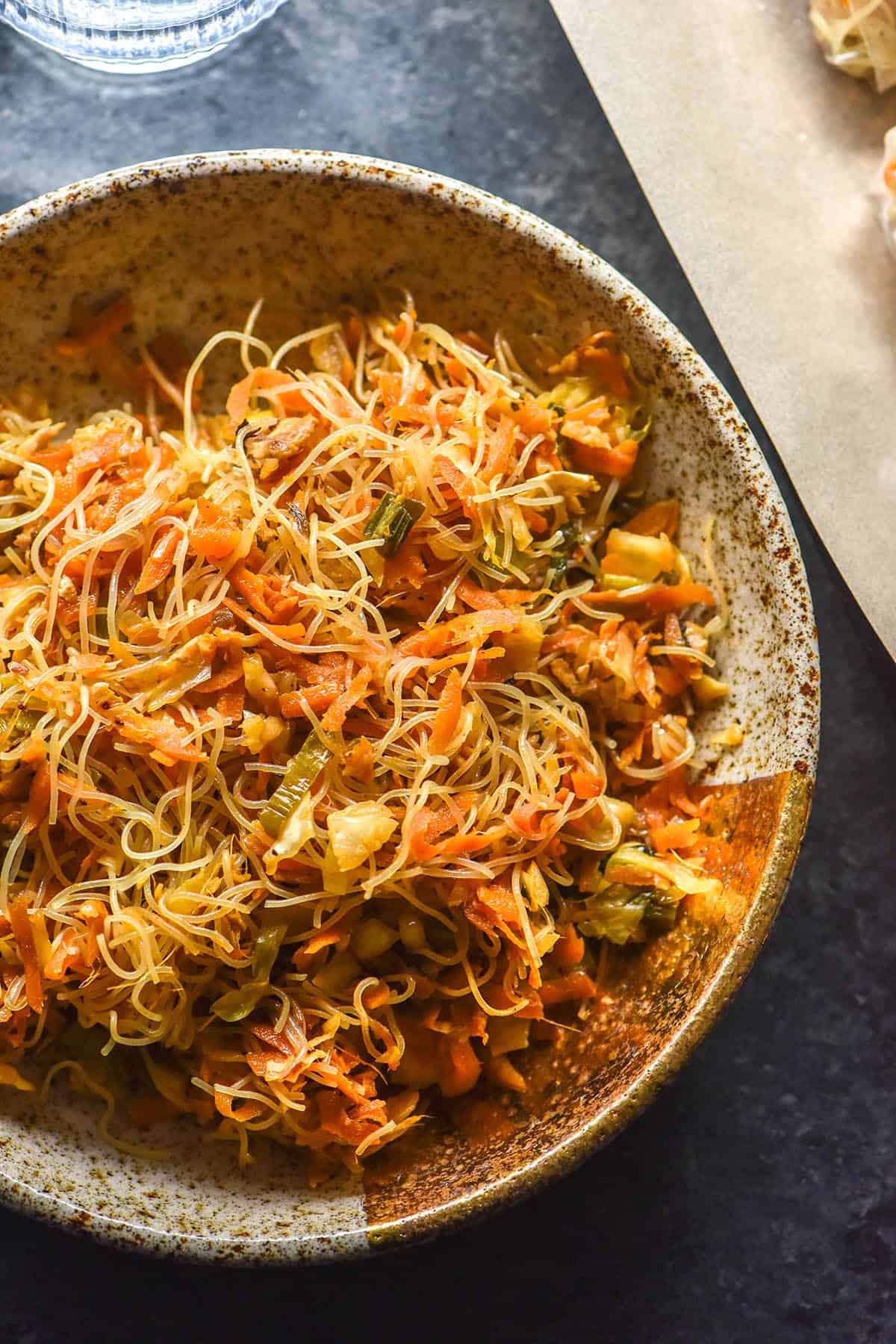
If you are using this recipe as a standalone dish
I am obsessed with this filling and I could eat it as a standalone dish. If you intend to do the same while on a low FODMAP diet, I have a few tips. I would say one batch makes about 2 meals, depending on your appetite. With this in mind, there are a few FODMAP tweaks to be made.
- Use 22-34g of fresh shiitake. There is a bit of wiggle room as to what constitutes a low FODMAP serve, hence the option.
- Alternatively, use 16-24g dried shiitake.
- Common cabbage is low FODMAP in 75g serves and moderate for fructans in 194g servings. It should remain safely under a low FODMAP threshold when serving 2-4 in regards to fructans – the recipe uses 250g common cabbage.
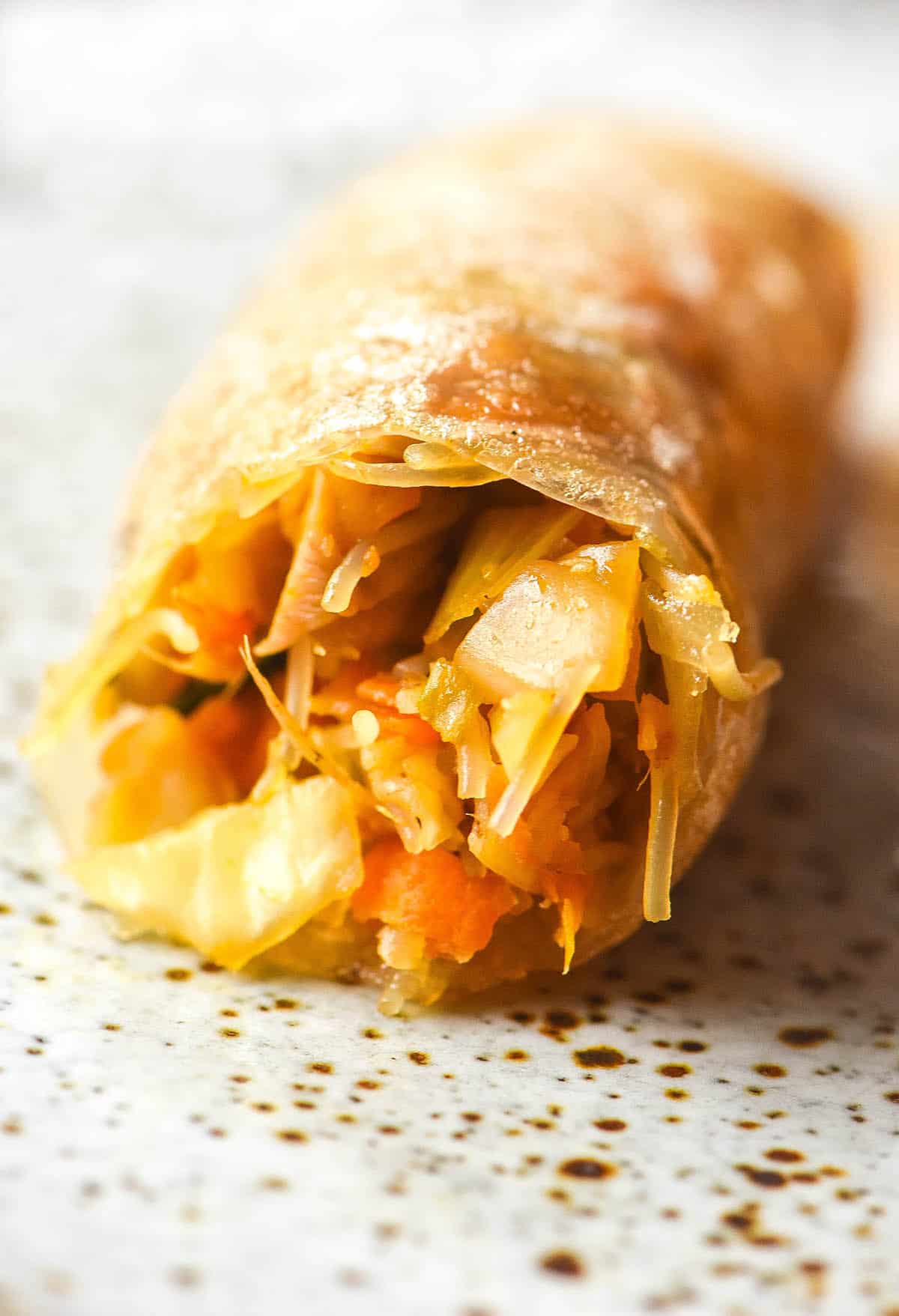
If you are using this recipe to make rice paper rolls
I am in the process of perfecting a gluten free spring roll wrapper, but we’re not there yet. All of my results so far haven’t been exactly what I’m after so I am yet to publish a recipe.
With that said, I figured some of you may like to use this filling to make rice paper rolls. They can be eaten fresh (with an upcoming low FODMAP sweet chilli sauce recipe or my low FODMAP dumpling dipping sauce). They can also be pan fried in a bit of oil for a crispy result.
To make the filling into rice paper rolls, you’ll need at least 13 wrappers. I like to keep plenty on hand in case wrappers break during rolling or are cracked to begin with. How many times you wrap them depends on what you plan to do with them. If you want to attempt to deep fry them, double wrap them. I have plenty of tips for doing this in my cookbook.
Keep in mind that your rolls will be chewier the more times you wrap them, particularly at the corners.
If you plan to shallow/pan fry them, you can get away with only wrapping them once. However, you will need to ensure your pan is extremely well preheated (prior to adding any oil) to ensure that they don’t stick and pull apart. I can’t overstate how important the preheating is. Rice paper is sticky at the best of times!
Of course, if you intend to eat them fresh, a single wrap is sufficient.
More low FODMAP recipes
- Gluten free vegan dumpling wrappers
- Low FODMAP bok choi and tofu dumpling filling
- Gluten free steamed buns without xanthan gum
- Low FODMAP crispy rice salad (Nam Khao inspired)
- Low FODMAP tofu larb (vegan)
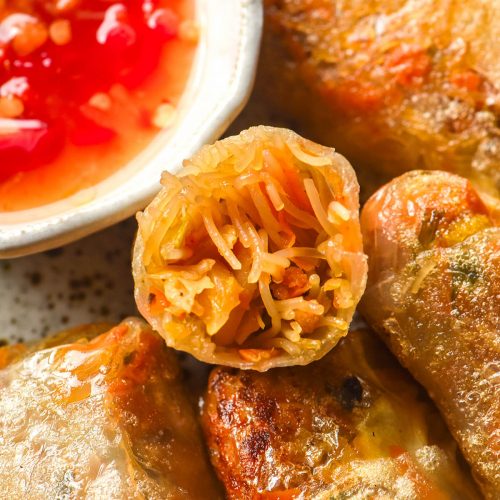
Low FODMAP spring roll filling
Ingredients
- 50 g rice vermicelli noodles
- 250 g carrot grated on the largest side of the grater
- 250 g common cabbage grated on the largest side of the grater
- 1 teaspoon fine salt
- 60 ml (3 tablespoons)* neutral oil
- 50 g ginger finely grated
- 1 bunch spring onion greens finely chopped
- 30 g dried shiitake or 50-60g fresh shiitake finely chopped
- 40-60ml (2-3 tablespoons)* vegetarian oyster sauce or to taste
- Pepper to taste
Instructions
- Soak the rice noodles in some room temperature water. Set aside while you work on the filling.
- Place the grated carrot and cabbage in a large sturdy sieve over the sink. Sprinkle over the salt then use your hands to massage it into the vegetables. Begin to squeeze the excess moisture from the vegetables in intervals. I like to work on them for about 10 minutes, on and off. They should have the excess liquid drained from them, look a little shrivelled and hold together in a ball. Removing excess liquid makes it much easier to form spring rolls and stops the liquid from making the pastry soggy, so this step is important.
- Heat a large skillet or pan over a medium heat. Add the oil and heat until shimmering.
- Add the ginger, spring onions and shiitake to the pan. Cook for 3-5 minutes or until soft and fragrant. Add a tiny splash of water if you need it.
- Add the drained vegetables to the pan and stir to combine.
- Use scissors to chop the vermicelli into short strands. They might feel a little tough and solid – this is perfect. We don’t want them to be overcooked. Add them to the pan and stir to combine.
- Pour over the oyster sauce and stir until the mixture is evenly coated. Add the pepper, then taste and adjust for sauce and seasoning.
- Remove from the heat and allow to cool before using. You can also make this as a stir fry noodle dish (see body of post) and to make rice paper rolls (see body of post).
- Leftovers keep well in the fridge for 3-4 days.
Notes
- See the body of the post for FODMAP notes.
- See the body of the post for instructions on making this into a low FODMAP stir fry dish.
- See the body of the post for instructions on making this into rice paper rolls.

No Comments